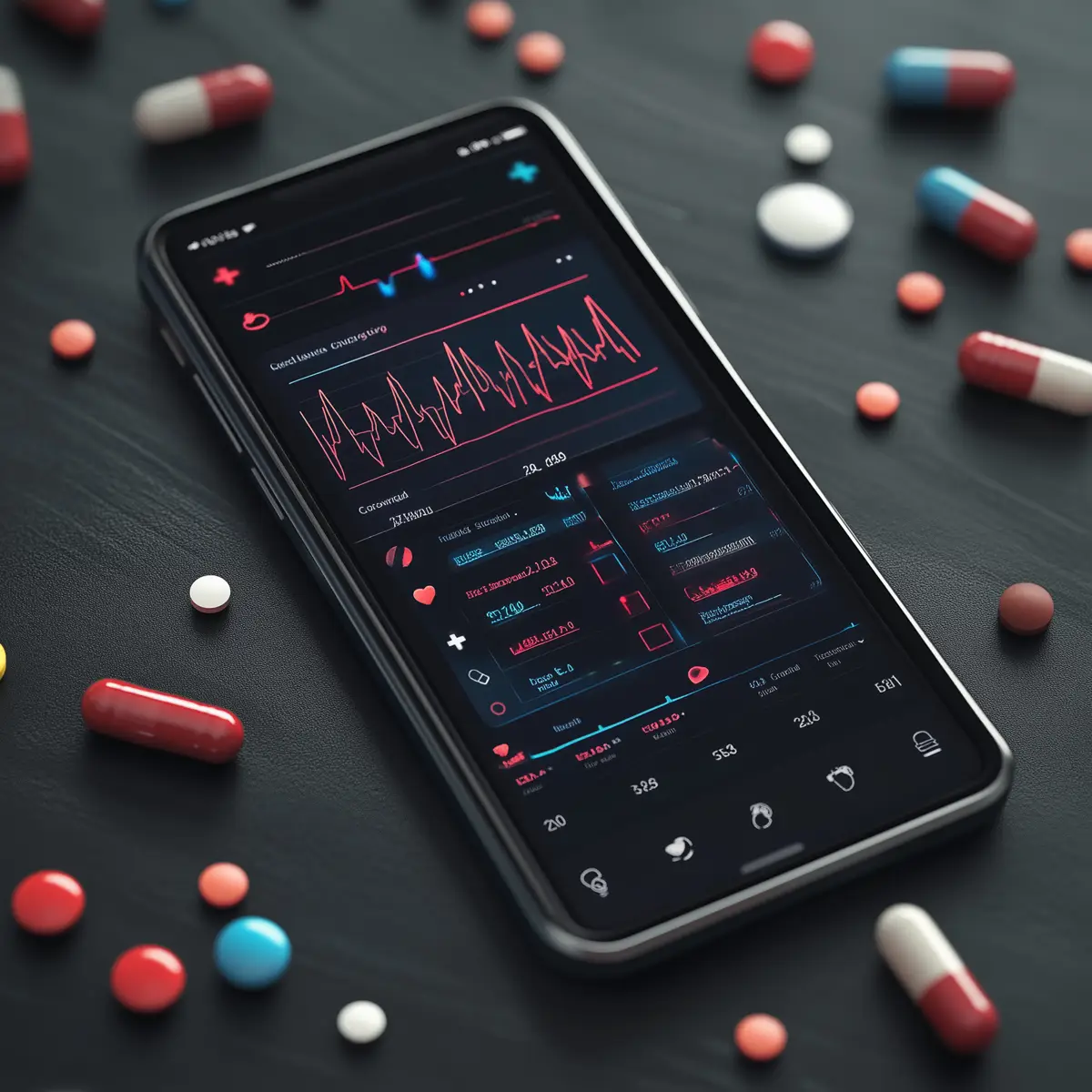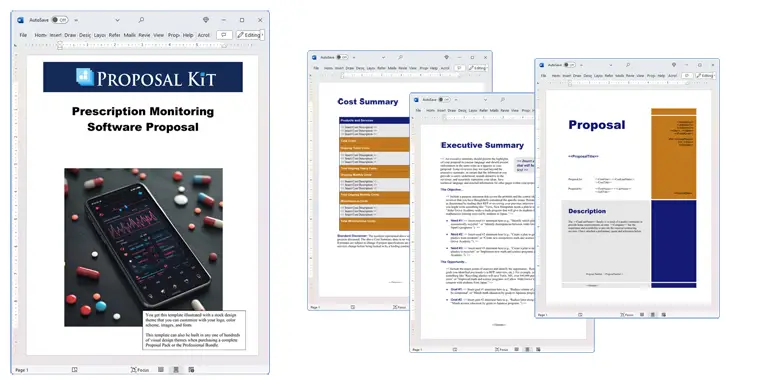How to write your Prescription Monitoring Software Proposal
We include this 22 page layout with every Proposal Pack. If you want this template to have a different visual design theme than the one illustrated here, purchase any Proposal Pack design and create this template using the purchased design theme. This template is included in every Proposal Pack. If you get a Proposal Pack or the Professional, you can also make any variation of this template with different chapters to suit your needs.
We typically include more chapters in the templates than most people will need to give everyone more variety in the chapters they may need. You can trim down a long template by removing pages you do not need or combining multiple chapter topics into one page.
 DOWNLOADABLE, ONE-TIME COST, NO SUBSCRIPTION FEES
DOWNLOADABLE, ONE-TIME COST, NO SUBSCRIPTION FEESYou can also create countless variations of this document to suit your needs using the included library of 2200+ chapters if ordering a Proposal Pack or Professional.
 What Our Clients Say
What Our Clients SayI have been using Proposal Pack for 7 months now and have to say it is simply the best software I have used for delivering professional proposals to my clients. Our company has to date delivered 40 proposals [approximately $350,000 in bids] and have secured all of them. I give credit to Proposal Pack for helping me deliver these in a timely manner."
TodlWeb Inc.
Related Article
Related Video
Related Templates
- Software Installation and Training Proposal
- Technology Strategy Analysis
- Software Beta Testing Project Proposal
- Software System Testing Project Proposal
- Cloud Computing Services Proposal
- Software as a Service (SAAS) Proposal
- Custom Software Development Proposal
- Mobile App Software Development Proposal
- Long Term Healthcare Services Proposal
- Managed Healthcare Services Provider Proposal
- Software Licensing Sales Proposal
- Pharmacy Startup Business Plan Funding Proposal
- App Development Proposal Template
- Healthcare Epidemic Outbreak Prevention and Response Proposal
- Healthcare Outsourced Services Provider Proposal
- Training Services for Software Proposal
- Medical Support Project RFP Response Proposal
What's the Best Way to Write Your Prescription Monitoring Software Proposal?
Proposal Kit offers a proven solution when creating a prescription monitoring software proposal. This software package includes a comprehensive template library and a Wizard software program that simplifies custom proposal creation. The Proposal Kit software integrates a line item quoting database for detailed cost summaries, quotes, estimates, budgets, and other financial documents important in proposal writing.
Are you in a situation where you must write a prescription monitoring software proposal or something similar? Proposal Kit has you covered.
What Types of Projects Are Prescription Monitoring Software Proposals Written For?
Prescription monitoring software projects vary widely but typically involve detailed planning and technical specifications. Here are examples of situations that proposals are written for:
- New prescription drug monitoring program implementations
- Upgrades to existing pharmacy software systems
- Integration of prescription monitoring with hospital information systems
- Cross-state or cross-region data-sharing initiatives
- Compliance projects for federal or state regulations
- Projects involving the secure handling of sensitive health data
- Implementation of analytics tools for drug usage patterns
- Development of user-friendly interfaces for medical professionals
- Mobile app developments for real-time monitoring
- Training programs for new monitoring software users
- Research initiatives involving prescription data analysis
- Public health studies supported by prescription data
- Software patches and security enhancements
- Development of reporting tools for pharmacy boards
- Customization projects for specific pharmacy needs
- Pilot testing new software with select pharmacies
- Roll-outs of software updates across multiple locations
- Pharmacy audit and compliance checking tools
- Integration with medical insurance claim software
- Projects aimed at reducing prescription drug abuse
Chapters this template is built with
Creating a comprehensive prescription monitoring software proposal involves several key topics. While no single pre-made template fits all situations, Proposal Kit creates custom proposals with its extensive template library, ensuring every necessary topic is covered. Here are examples of chapters from the content library used in this type of proposal:
Cover Letter
The cover letter serves as a personal introduction to your proposal. It sets the stage by briefly mentioning the project's purpose and relevance to the pharmacy board. This is the first impression, so it should convey professionalism and a clear understanding of the pharmacy board's needs.
Executive Summary
The executive summary provides a high-level overview of your project, highlighting the main goals and benefits to the pharmacy board. It should briefly explain how the prescription monitoring software will enhance efficiency, ensure compliance, and improve patient safety.
Cost Summary
Use Proposal Kit's line item quoting tool to present a detailed cost breakdown. This section ensures clear financial communication by listing software development, implementation, training, and ongoing maintenance costs. Transparency here builds trust and sets realistic economic expectations.
Needs Assessment
This section details the specific needs of the pharmacy board that your software aims to address. Identify current challenges, such as managing prescription data, tracking drug dispensation, and ensuring regulatory compliance, and explain how your solution meets these needs.
Benefits
Outline the advantages of implementing your software, such as improved prescription management efficiency, better compliance with regulations, and enhanced ability to monitor and prevent prescription drug abuse. Use data and case studies to substantiate these benefits.
Project Deliverables
Specify what the pharmacy board will receive upon project completion. This includes the software, user manuals, training materials, and ongoing support services. Clear deliverables help the client understand exactly what they are investing in.
Records Access Security Plan
Describe the security measures that will protect sensitive prescription data. This includes encryption methods, user access controls, and compliance with data protection regulations. Highlighting robust security measures is crucial for gaining client trust.
Development
Explain the software development process, including methodologies and frameworks used. Discuss phases such as requirements gathering, design, coding, testing, and deployment. This gives the pharmacy board confidence in your structured approach to delivering a reliable product.
Content Management
Discuss how prescription data will be managed and updated within the system. Explain the data input methods, storage solutions, and retrieval processes. Emphasize the ease of use and reliability of your content management system.
System Integration
Detail how the new software will integrate with existing systems within the pharmacy board. Address compatibility with current hardware, software, and databases. Successful integration is key to minimizing disruption and ensuring smooth operation.
Implementation Schedule
Provide a timeline for all key milestones from development to deployment. Include initial setup, pilot testing, full-scale deployment, and post-launch support. A clear schedule helps the pharmacy board plan and allocate resources accordingly.
Vital Records
Describe how vital records are handled to ensure they are always accessible yet secure. This might include backup solutions, disaster recovery plans, and secure access protocols. Ensuring the integrity and availability of vital records is crucial for compliance and operational continuity.
Hardware and Software
List the hardware and software requirements necessary to support the new system. Include details on servers, workstations, network infrastructure, and third-party software dependencies. This will help the pharmacy board prepare its IT environment for the new solution.
System Requirements
Detail the technical specifications that the new software will fulfill. This includes processing power, memory, storage, and network bandwidth requirements. Clear system requirements ensure the client's infrastructure adequately supports the new software.
Monitoring
Explain how the system will monitor prescription activities and generate relevant alerts. This includes real-time data tracking, reporting capabilities, and automated notifications for suspicious activities. Monitoring features are important for proactive management and compliance.
Cost Analysis
Provide a detailed analysis of the projected costs against the anticipated financial benefits. Discuss initial investment versus long-term savings through improved efficiency and reduced risks. A thorough cost analysis helps justify the investment in your software.
Recommendations
Offer recommendations for the deployment and use of the software system. This might include best practices for rollout, staff training, and ongoing support. Tailored recommendations demonstrate your commitment to the client's success.
Quality Control
Describe the measures in place to ensure the quality of the software throughout its lifecycle. This includes testing protocols, user feedback loops, and regular updates. Highlighting robust quality control processes reassures the client of the software's reliability.
Standards Compliance
Ensure that the proposal meets all regulatory standards applicable to prescription monitoring software. This includes compliance with federal and state regulations, industry standards, and best practices. Adherence to standards is critical for legal compliance and operational integrity.
Use cases for this template
Transforming State-Wide Prescription Monitoring Systems
The Challenge
Working for HealthTrack Solutions, John noticed significant inefficiencies in state agencies monitoring prescription drug use. The system was outdated and slow, causing delays and potential healthcare risks. Data inaccuracies and slow reporting times often resulted in missed opportunities to intervene in cases of prescription drug abuse. John knew an overhaul of the system was necessary to protect public health and ensure compliance with new state regulations.
The Solution
John proposed implementing a new, streamlined prescription monitoring software designed by his company. The software promised real-time data processing, comprehensive reporting capabilities, and enhanced user interfaces to improve accessibility for healthcare providers. To gain approval, John needed to present a detailed and convincing proposal addressing the existing system's flaws and highlighting the new software's benefits.
The Implementation
Using the Proposal Kit, John drafted a proposal outlining how the new system would improve efficiency and compliance. He included detailed timelines and cost estimates to support his claims. The proposal also featured a needs assessment, highlighting the system's shortcomings and a benefits section detailing how the new software would mitigate these issues. Proposal Kit's line item quoting database allowed John to present a clear cost summary, which was crucial for gaining stakeholder confidence.
The Outcome
The state agency approved the project, and the new system was implemented successfully. The improved software significantly enhanced prescription monitoring and patient safety throughout the state. Healthcare providers could now access real-time data, leading to faster and more accurate decision-making. The state saw a substantial reduction in prescription drug misuse and abuse, fulfilling John's vision for a more effective and compliant monitoring system.
Rapid Implementation for Hospital Pharmacy Compliance
The Challenge
Sarah, a project manager at MedTech Innovators, was tasked with urgently implementing a prescription monitoring system in an extensive hospital network. The deadline was tight due to upcoming regulatory audits, putting pressure on Sarah and her team to deliver a functional system quickly. The existing software was outdated and non-compliant with new healthcare regulations, causing a significant hospital accreditation risk.
The Solution
Sarah turned to Proposal Kit to expedite the proposal writing process. She used the software to organize her proposal logically and persuasively. Proposal Kit provided Sarah with various templates that she customized to outline the benefits of the new software, ensuring that each section of the proposal was thorough and tailored to the hospital's specific needs.
The Implementation
Sarah highlighted the software's ease of integration and user-friendly features, using charts and graphs to illustrate her points. She also included a detailed implementation schedule that showed how the project could be completed well before the audit. Cost estimates were itemized using the Proposal Kit's quoting tools, adding transparency to the proposal's financial topics.
The Outcome
The hospital board was impressed by the thoroughness of the proposal and the clear implementation plan. They swiftly approved the project, and Sarah's team immediately began deploying the new software. Thanks to the efficient implementation, the hospital met its compliance requirements before the audit. The new system improved prescription monitoring processes, ensuring the hospital maintained its accreditation and provided high-quality patient care.
Enhancing Monitoring Capabilities for a Non-Profit
The Challenge
Tom, a director at a non-profit focused on drug abuse prevention, needed to secure funding for a prescription monitoring program to serve their community better. The non-profit aimed to implement a system to track prescription trends and identify potential abuse patterns. However, securing the necessary funding required a detailed and persuasive proposal that demonstrated the program's benefits and necessity.
The Solution
Tom used the Proposal Kit to create a detailed proposal explaining the program's necessity and benefits. The templates provided by Proposal Kit allowed Tom to structure the proposal, ensuring that each section conveyed the critical points succinctly. He focused on how the software could aid in the early detection of drug abuse trends and provide valuable data for preventative measures.
The Implementation
The proposal outlined how the software could track prescription trends and identify potential abuse patterns. Tom included real-world examples, case studies to support his arguments, and a cost analysis detailing the funding needed and projected financial benefits. He also added a section on how the program aligned with the non-profit's mission and goals, making a solid case for why the investment was worthwhile.
The Outcome
The proposal was well-received, and the non-profit secured the necessary funding to implement the monitoring program. The non-profit could monitor prescription trends and intervene in potential abuse cases with the new software. This enhanced their ability to serve the community, resulting in better outcomes for individuals at risk of prescription drug abuse and reinforcing the non-profit's impact on public health.
Conclusions and Recommendations
Proposal Kit can be invaluable for anyone writing a prescription monitoring software proposal. From providing customizable templates and financial documentation tools to creating compelling content that addresses specific needs, Proposal Kit is a proven solution for professionals across the healthcare and technology sectors.
Also Known As
This template may also be referred to in different ways or be used in more specialized situations, such as:
- Prescription Surveillance System Proposal
- Pharmacy Software System Project Proposal
- Drug Monitoring Application Proposal
- Prescription Data Management Plan
- Medication Tracking System Proposal
- Pharmaceutical Compliance Software Project
- Prescription Security System Proposal
- Health Data Analysis Software Proposal
- Pharmacy Board Software Upgrade Proposal
- Prescription Audit System Implementation Plan
Abstract
 Prescription monitoring systems have become an important tool in addressing the opioid epidemic and enhancing patient outcomes, particularly for chronic pain patients. With increasing cases of opioid use disorder and fatal drug overdoses, it is crucial for healthcare providers to efficiently manage and monitor controlled substance prescribing. Prescription monitoring software proposals aim to implement systems that prevent doctor shopping and reduce the supply of prescription opioids, thereby mitigating risks associated with illicitly manufactured fentanyl and other stimulants.
Prescription monitoring systems have become an important tool in addressing the opioid epidemic and enhancing patient outcomes, particularly for chronic pain patients. With increasing cases of opioid use disorder and fatal drug overdoses, it is crucial for healthcare providers to efficiently manage and monitor controlled substance prescribing. Prescription monitoring software proposals aim to implement systems that prevent doctor shopping and reduce the supply of prescription opioids, thereby mitigating risks associated with illicitly manufactured fentanyl and other stimulants.
Such proposals are often structured using a Word document template that covers important topics like data integrity, electronic health records integration, and systematic review of pdmp data. They also emphasize the importance of compliance with regulatory standards and improving high-risk patient treatment through data analytics.
Proposal Kit supports the preparation of these proposals with its extensive content libraries and automated line-item quoting, ensuring that each proposal addresses specific needs, such as enhancing hospital pharmacy compliance or deploying a technical assistance center. By incorporating user-friendly mobile apps and real-time monitoring, these software systems allow multiple prescribers and pharmacists to collaborate, ultimately improving the effectiveness of prescription monitoring programs and reducing the likelihood of overdose deaths.
 The implementation of these systems often involves a comprehensive needs assessment, followed by a clearly defined implementation schedule that outlines stages from pilot testing to full deployment. With options like lifetime licenses or subscription fees, organizations can choose a plan that aligns with their operational goals and budget. This structured approach aids other stakeholders, including Congress and healthcare departments, in understanding the critical role of prescription monitoring systems in combating the opioid overdose crisis and improving public health outcomes.
The implementation of these systems often involves a comprehensive needs assessment, followed by a clearly defined implementation schedule that outlines stages from pilot testing to full deployment. With options like lifetime licenses or subscription fees, organizations can choose a plan that aligns with their operational goals and budget. This structured approach aids other stakeholders, including Congress and healthcare departments, in understanding the critical role of prescription monitoring systems in combating the opioid overdose crisis and improving public health outcomes.
The implementation of prescription monitoring software is vital in addressing the complexities of opioid prescribing and managing controlled substances. This software not only aids in tracking prescription opioid use but also helps in identifying patterns of addiction and misuse through the analysis of data collected from multiple sources. By using advanced office software capabilities, healthcare providers can ensure comprehensive pdmp use, which is important in reducing high-risk behaviors associated with opioid misuse.
Proposal Kit plays a role in writing these important documents. Its robust features facilitate the creation of detailed proposals by offering complex document assembly and an extensive library of templates tailored to various healthcare needs. This includes the integration of knowledge from systematic reviews and surveys to create proposals that demonstrate the intended benefits of new monitoring systems. The ability to produce documents in formats like pdf ensures that proposals are accessible and easy to distribute among stakeholders.
 For healthcare institutions and other stakeholders, these proposals are an invaluable resource. They provide a clear roadmap for implementing systems capable of reducing the adverse effects associated with prescription opioid use. By enabling unlimited use of the software tools and offering insights into medication management, including alternatives like buprenorphine and gabapentin, the proposals demonstrate a commitment to improving treatment strategies and patient safety.
For healthcare institutions and other stakeholders, these proposals are an invaluable resource. They provide a clear roadmap for implementing systems capable of reducing the adverse effects associated with prescription opioid use. By enabling unlimited use of the software tools and offering insights into medication management, including alternatives like buprenorphine and gabapentin, the proposals demonstrate a commitment to improving treatment strategies and patient safety.
Furthermore, the software systems discussed in these proposals are designed to make a tangible difference in public health outcomes by enhancing the detection of misuse patterns and supporting interventions. They empower institutes to conduct thorough searches and analyses, ultimately leading to more informed decision-making processes. This proactive approach is critical in addressing the opioid crisis and ensuring that effective measures are in place to protect communities from the dangers of addiction and overdose.
Addressing high-risk situations in opioid prescribing and management is crucial for curbing the ongoing opioid epidemic. Prescription monitoring software is a key factor in identifying and mitigating these high-risk situations. By using systematic data collection and advanced analytics, healthcare providers can pinpoint patients at risk of developing an opioid use disorder. The software facilitates detailed tracking and reporting of prescription opioid use, allowing prescribers to make informed decisions and adjust treatment plans as necessary.
 The insights gained from these systems can significantly enhance patient care by identifying trends that might otherwise be uncovered. For instance, prescribers can use this information to recommend alternatives for treatment, thereby reducing reliance on high-risk opioids. Furthermore, the integration of this data into electronic health records ensures that all healthcare professionals involved in a patient's care have access to comprehensive information, reducing the likelihood of doctor shopping and misuse.
The insights gained from these systems can significantly enhance patient care by identifying trends that might otherwise be uncovered. For instance, prescribers can use this information to recommend alternatives for treatment, thereby reducing reliance on high-risk opioids. Furthermore, the integration of this data into electronic health records ensures that all healthcare professionals involved in a patient's care have access to comprehensive information, reducing the likelihood of doctor shopping and misuse.
Proposal Kit aids in the creation of proposals that not only address these systemic challenges but also offer solutions tailored to the specific needs of healthcare institutions. Its automated tools allow for the seamless assembly of proposals that articulate the benefits of implementing such systems, including improved compliance with regulations and enhanced patient outcomes. By framing these proposals and considering the situation of public health priorities, stakeholders can better understand the long-term impacts of prescription monitoring on community health and safety.
In summary, the use of prescription monitoring software, as detailed in well-structured proposals, plays a vital role in transforming healthcare practices related to controlled substances. It fosters a proactive approach to managing high-risk patients, ultimately contributing to a reduction in opioid-related harms and improving overall public health.
Frequently Asked Questions
What key topics should a prescription monitoring software proposal include?
Start with a cover letter and executive summary that provide an overview of the project. Include a detailed needs assessment to highlight the problems your software will address. Also, outline the benefits, provide a cost summary, and provide an implementation schedule. Finally, ensure you cover technical topics such as system requirements, security plans, and compliance with regulatory standards. Including these components will make your proposal robust and more likely to win approval.
How do I address the security concerns in a prescription monitoring software proposal?
Security is paramount in any prescription monitoring software proposal due to the sensitive data involved. Your proposal should include a Records Access Security Plan that details the encryption methods, access controls, and other security protocols you will implement to protect patient data. Additionally, address how your software complies with HIPAA regulations and other relevant legal standards. A comprehensive security plan will reassure stakeholders that their data will be safe and secure.
What strategies can I use to demonstrate the benefits of my prescription monitoring software?
Demonstrating the benefits of your prescription monitoring software is important to convincing stakeholders of its value. Use the Benefits section of your proposal to outline how your software will improve efficiency, enhance compliance, and provide better patient care. Include real-world examples, data, or case studies to support your claims. Use visuals like charts and graphs to make the information more digestible and compelling. Clearly articulating these benefits will help make a strong case for your proposal.
How should I structure the cost summary in a prescription monitoring software proposal?
The cost summary is essential to your prescription monitoring software proposal, as it gives stakeholders a clear understanding of the financial implications. Structure this section by breaking down all costs into detailed line items: development, implementation, training, and maintenance. Use Proposal Kit's line item quoting database to ensure accuracy and clarity. This straightforward approach will help stakeholders see the value of their investment and make it easier for them to approve your proposal.
What timeline should I propose for implementing a prescription monitoring software system?
Creating a realistic and detailed timeline is important for the credibility of your prescription monitoring software proposal. The Implementation Schedule section outlines each project phase, from initial development to full deployment. Include timeframes for key milestones such as software development, testing, training, and go-live dates. Be sure to factor in potential delays and contingencies. A well-thought-out timeline demonstrates your project's feasibility and helps build stakeholder confidence.
20% Off Discount
![]() Add To Cart This Word Template
Add To Cart This Word Template
 Add To Cart Proposal Pack for Any Business
Add To Cart Proposal Pack for Any Business
 Add To Cart Proposal Kit Professional
Add To Cart Proposal Kit Professional
 4.7 stars, based on 849 reviews
4.7 stars, based on 849 reviewsProposal Kit chapters used in this template
Cover Letter, Title Page, Table of Contents, Executive Summary, Needs Assessment, Benefits, Development, Monitoring, Content Management, Vital Records, Records Access Security Plan, Standards Compliance, Quality Control, Hardware and Software, System Integration, Project Deliverables, Implementation Schedule, System Requirements, Cost Summary, Cost Analysis, Recommendations, Back Page
Line Item Automated Chapters
If you purchase a Proposal Pack or the Professional Bundle, these proposal pages are generated using an automated line-item database in the included Wizard software.
Cost Summary, Implementation Schedule
You use this proposal for
- General business proposal
- Technical proposal
- Project pitch proposal
- Medical, healthcare, wellness proposal
- IT, software, hardware proposal
How to create this template with Proposal Pack Wizard
You can create this document using any of the logo-designed Proposal Packs. Pick any Proposal Pack with a logo design theme you like best; they will all work equally well. The Proposal Pack for Any Business is the pack with no extra added logos or colors - designed to be used plain or for you to customize with your logos and graphics.
The Proposal Pack design theme you purchase will determine the visual look of this template. The screenshot above only shows the plain generic design theme.
We include a library of chapters to be assembled based on your needs. All proposals are different and have different needs and goals. We designed Proposal Pack so you can customize the documents to suit your needs.
You will best create this document using the Proposal Pack Wizard - Expert Edition software to select this template and build it in the Proposal Pack logo design theme of your choice along with any desired customizations (such as adding additional chapters, removing unneeded chapters, changing the order of chapters, and importing your company logo). This template outlines a proposal for the described situation. Each user is responsible for typing in the actual content of the provided pages with their information to complete the proposal. Suggestions in the abstract may include features in higher-end packages and are facilitated by the selection of chapter templates to support the narrative of each proposal, which help guide the user in filling in the details.
The Wizard software's AI Writer will write the content of the pages of the template based on details provided for your company, client, project, financial details and other writing instructions. This will provide a personalized version of the template completely written and ready to edit.
Once finished, the AI Writer's Word-to-PowerPoint converter can transform your proposal, business plan, or other business documents into a PowerPoint slideshow. Save time and effort by letting the AI analyze every chapter to condense its content into talking points, visually matching the document, and providing a consistent package of presentation material with the click of a button.
You create this template using the Wizard software with an entire Proposal Pack library and software. We include the Expert Edition of the software in the Proposal Kit Professional. Microsoft Word for Windows is required to use the customizing software. You can also edit Word document templates in other office software such as Word for Mac. We will assist Mac users in assembling complex templates for their first project if they do not have the required platform to run the Wizard software.
How to Build Templates Featured on Proposal Kit Website
Many people find the Proposal Kit website after searching for a specific proposal. Once you've purchased and installed the software, how do you build that template you found in the first place? This video shows you how to build any proposal you see on the Proposal Kit website.
 Ian Lauder has been helping businesses write their proposals and contracts for two decades. Ian is the owner and founder of Proposal Kit, one of the original sources of business proposal and contract software products started in 1997.
Ian Lauder has been helping businesses write their proposals and contracts for two decades. Ian is the owner and founder of Proposal Kit, one of the original sources of business proposal and contract software products started in 1997.By Ian Lauder
 Published by Proposal Kit, Inc.
Published by Proposal Kit, Inc.


 Cart
Cart
 Get 20% off ordering today:
Get 20% off ordering today: 


 Facebook
Facebook YouTube
YouTube Bluesky
Bluesky Search Site
Search Site